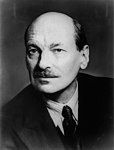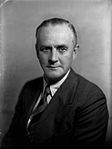A general election was held in the United Kingdom on Thursday 25 October 1951, and all 71 seats in Scotland were contested.[1] The Unionists, together with their allies the National Liberals, ended up narrowly ahead of Labour in terms of vote share, however the two were equal in terms of seats won, each taking 35 seats. When combined with results from across the UK, the Conservatives (with whom the Unionists sat at Westminster) won a majority of 17 seats, despite winning slightly fewer votes than Labour. The election is noteworthy for being, as of 2024, the last election in which the Conservatives did better in Scotland than in England.
| |||||||||||||||||||||||||||||||||||||||||
All 71 Scottish seats to the House of Commons | |||||||||||||||||||||||||||||||||||||||||
|---|---|---|---|---|---|---|---|---|---|---|---|---|---|---|---|---|---|---|---|---|---|---|---|---|---|---|---|---|---|---|---|---|---|---|---|---|---|---|---|---|---|
| |||||||||||||||||||||||||||||||||||||||||
 Results of the 1951 election in Scotland Conservative/Unionist Labour Liberal National Liberal | |||||||||||||||||||||||||||||||||||||||||
The Liberals were reduced to one Scottish seat, Orkney and Shetland, losing their only other seat (Roxburgh and Selkirk) to the Unionists.
Results
edit| Party | Seats | Seats change | Votes | % | % Change | ||
|---|---|---|---|---|---|---|---|
| Conservative and Unionist (Total) | 35 | 4 | 1,349,298 | 48.6 | 3.8 | ||
| Unionist | 29 | 3 | 1,108,321 | 39.9 | 2.7 | ||
| National Liberal & Conservative | 6 | 1[b] | 240,977 | 8.7 | 1.1 | ||
| Labour Party | 35 | 2 | 1,330,244 | 47.9 | 1.7 | ||
| Liberal | 1 | 1 | 76,291 | 2.7 | 3.9 | ||
| Communist | 0 | 10,947 | 0.4 | 0.6 | |||
| SNP | 0 | 7,299 | 0.3 | 0.1 | |||
| Other | 0 | 1[b] | 3,758 | 0.1 | 0.9 | ||
| Total | 71 | 2,777,837 | 100 | ||||
Votes summary
editNotes
edit- ^ The seat and vote count figures for the Unionists given here include the National Liberals.
- ^ a b John MacLeod had fought the 1950 election as an Independent Liberal, but switched to being an official "Liberal and Conservative" (taking the Conservative whip at Westminster) for the 1951 election. His seat, Ross and Cromarty is thus shown as National Liberal gain.
References
edit- ^ "Commons results report" (PDF). Archived (PDF) from the original on 12 November 2020.


